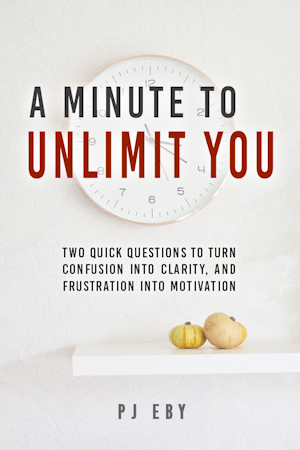A few days ago, I wrote about motivation and “chunking up” to link detail-level tasks to life-scope goals, and that I was going to try out the techniques of described by a Tony Robbins course that happened to have some similar features to the ideas I had. Well, I didn’t really do all the steps his system proposed, but on Thursday I did succeed in being marvelously productive, moving forward a whole bunch of projects in a short period of time and feeling quite splendid about it.
Then Friday came and everything went to hell. I barely got any work done on anything, could scarcely concentrate, it was horrible. I had trouble even going through the motions of the organizational techniques I’d used the previous day. It was terribly depressing.
However, lately my mantra has been that we can learn a lot more from our failures than we can from our successes. And it’s true, we can. My Thursday success didn’t really teach me much; I’ve had super-productive days before, after all. An isolated success doesn’t give you repeatability or control. But now I had a success, followed immediately by a failure, giving me a high-contrast basis for comparison.
One of the first things I learned was this: my vision tends to become iconic and symbolic. The inspiring thoughts of Wednesday and Thursday became symbolic representations by Friday, and therefore had no emotional zazz at all. The second thing I realized was that most of the stuff I tried to get myself to do on Friday was stuff that I had not actually taken the time to mentally chunk up into their overall life context – but I actually did accomplish a few things on Friday that I had previously put in context.
So Saturday was my time to experiment and see if I could get back in the groove. But something just wasn’t working. I’d try to visualize the same things I did before, but I just wasn’t responding to them. I tried to remember what I did differently on Wednesday and Thursday, and became aware that I was using my imagination differently. The stuff that had worked, I had imagined as if it were virtual reality – I was seeing things from inside my visions. What didn’t work was stuff I saw as if it were on a TV or movie screen off in front of me somewhere.
However, for some reason, I couldn’t seem to make myself return to the way of imagining that worked. Somehow, it just didn’t feel right to me. I experimented a bit with music and sound, as I had noticed previously that I have an easier time mapping from sound to feeling than sight to feeling. (Interestingly, I can easily map from sight to taste, and my mouth literally waters when I envision good sex or elegant software!) But nothing was working.
At that point, I speculated to Leslie that maybe the trick was all the time I spent blogging about this the other day. Maybe I needed to talk out what I was thinking about in order to successfully map from the visions to the feeling of motivation. She asked if I had read back my article, and I kind of brushed off the idea, because reading and writing aren’t the same thing for me; I don’t have the same kind of experience reading what I wrote as I do writing it. When I write, I’m not 100% certain what I’m going to say and often surprise myself quite a bit with my insights as I go. When I read back what I wrote, there are no surprises.
But then I realized her advice made sense. Reading it back would be the best way to figure out what the hell I was thinking before that made things work. So I went back and read the article, skimming ahead to the section where I described the “mmmm” test, and about linking things to your life as a whole. And that was when I “got it”.
Discovering Command Mode, Again
The principal thing that was different between “working” and “not working” was that when I wrote the article and put it into practice, I was in command mode. More specifically, I was in a state of readiness to act, knowing that I was in control and it was up to me to choose what to do.
Even more specifically, I was asking myself, “What do I want to do with my life? What do I want to do about it now?” These and similar questions were burning in my brain when I wrote the original article, and echoed through my day on Thursday, but were no longer with me by Friday. On Friday, I thought I had it all figured out and knew what I “should” do. I then proceeded, as usual, to not do anything I “should” have done. I had lost rapport with myself, falling into an old pattern of should-ing and resistance. I became literally passive-aggressive, in the sense that I had one part of me aggressively trying to force the passive part of me to get some work done, for goodness’ sake.
That aggressive part was just trying to use my discoveries about motivation to “motivate” the passive part. It wasn’t asking what I wanted to do with my life. It was only asking how to motivate me to do what it had already decided I should do!
No wonder things weren’t working. I was playing out the same old drama, and only the props had changed. My insight about motivation had just become the latest tool to beat myself up with. And in writing this now, it’s easy to see why every organizational or motivational technique I’ve ever used has worked a while and then stopped. As soon as it produces some success, my inner taskmaster takes over and uses it to beat me into shape. If I succeed at something once (or so goes its logic), then I should damn well do everything I’m supposed to, right pronto. This inner parent then goes head-to-head with my inner child, who doesn’t have to, doesn’t want to, and ain’t gonna.
So when I realized today the difference between being in command, and commanding myself, I thought about this: in The Path of Least Resistance, Robert Fritz writes about primary choice, secondary choice, and fundamental choice. A primary choice is a result you choose to have for its own sake. A secondary choice is one you make in order to bring your primary choice to fruition. But a fundamental choice is a choice you make about your life and being.
As Fritz puts it, many people choose to exercise without making the choice to live a healthy life. Many people set goals, but most do so without having made the choice to be the primary creative force in their lives. Without these fundamental choices, their primary and secondary choices often don’t work, because there isn’t a structure in place that supports the goals. In a sense, the goals are without roots, and when the weather gets bad, they can wither and die.
Decisions Are In Your “Gut”
So this is the key. When I’m “coming from” a state of mind where I am the primary creative force in my life, where I am living now in the life that is mine (and only mine) to live, then I find that I literally “step into” my body and vision. Indeed, it becomes apparent to me now that most of my life, I haven’t actually been living in my body. I don’t mean I can’t see or hear or taste or smell, I just mean that I mostly stay cut off from touch. I think I learned at a fairly young age to stay distant from my feelings, not merely in the emotional sense but in the tactile one as well.
Without such grounding in my body, I lacked a connection to the visceral “gut” feelings needed to make good decisions on a personal level. On Wednesday and Thursday, I had made such a connection, but lost it again by Friday, because I hadn’t really been aware of that aspect of what I was doing. On Saturday I recognized the feeling when I felt it again, and knew then that I was on the right track. To get motivation, I have to be in my body. To be in my body, I have to choose to be here, because I want to be here and because I want to know what I want, and I want to go get it. This is the true “command mode”.
The Body is the Key to Action – Even “Mental” Action
And as I think back now on all the articles I’ve written since I started this blog, about acting without hesitation, getting from “think” mode to “do” mode, and so on, it’s now clear to me that body sensation has been the invisble elephant in the room the whole time. It’s only possible to act without hesitation when you’re in-body. In-body is “do” mode.
It’s what the NLP people call “uptime”, and in most of my life I’ve only used it to perform for others, in the sense of being entertaining (as a public speaker and as an amateur magician), or doing selling, doing training, doing consulting work, etc. I never really made the connection there either; it was just something I did. I never isolated the key components, or consciously applied it to anything. It’s just something I was or wasn’t.
It also makes more sense to me now why, when I used to attend regular zazen (meditation) at the Maria Kannon Zen Center (when I lived near Dallas), I tended to be very calm and clear in my decision-making. Zen meditation definitely makes it easier for me to be in-body, in the state of quiet readiness that was a hallmark of my experiences this Thursday and Saturday.
So what else happens in this uptime, in-body, captain-of-my-fate, command mode thing? Well, I had a super-productive and enjoyable Saturday, that’s for certain. The specific practice of chunking up to life-level goals was perhaps mildly helpful, but it didn’t seem all that necessary.
I think maybe all that happened the other day is that the chunking up helped me get into the right mode, but wasn’t actually that significant to the process of carrying out the steps I wanted to do. And today, I was fine with mostly just carrying through on previously chosen steps. The key was that I was asking myself what I wanted to do, and then using my visions and feelings to make choices. I wasn’t pestering myself to do things; instead I was in the driver’s seat, deciding where I wanted to go.
So now it’s clear to me what hasn’t been working, and why, and why I’ve never previously been able to sustain my erratic bursts of super-productivity. No productivity trick or technique, be it organizational or motivational, will ever satisfy your inner drill sergeant, who thinks you should always be doing all the right things, all the time, based on criteria that may or may not be yours. In any case, no technique works unless you do, and no mere productivity technique can bridge the gap between the you that wants things to get done, and the you who just wants to be left alone. You need to be one person, not two, and the easiest way to ensure this is a solid grounding in physical reality. In your head, you can be of two minds, but there can be only one when you inhabit the body.
Now, the thing is, I’ve gone through the ups and downs of so many techniques that I’ve lost count, and failed so many times that I almost don’t dare believe in this discovery. My skeptical side says, I’ll believe it when I see a solid week of hyper-productivity. Or better yet, make it two. But my optimistic side points out that this is the very first time I’ve had a theory that explains every instance of hyper-productivity that I can remember, and the first theory that has twice produced it upon demand, starting from a blocked state.
So if I become blocked again, I won’t be discouraged. I will simply go around it, by becoming… myself. It’s true that yesterday I was lost, but today I’m only here. And so, tomorrow and tomorrow and tomorrow: I will be the body, and I will be whole.











Just wanted to say that I’ve really been getting a lot of out of these articles. The I-am-in-command mode is very interesting. I think I might try it out even if it results in me deciding to (gasp) take a break from time to time! 🙂
I can’t find your e-mail anywhere on the site, so I will ask here – I really like your articles here on dirtsimple.org, and I would like to translate some of it into my native language – Polish, and put on my blog (of course with link to the orginal etc.). Do you mind?
“””I think I might try it out even if it results in me deciding to (gasp) take a break from time to time! :-)”””
Breaks are definitely a part of life. I reorganized a significant part of my garage yesterday, and then enjoyed dinner and a movie with my spouse, followed by writing this article. Balance is much easier if you are in-body; but if you’re in your head then it seems crazy imbalances are the default setting!
“””I would like to translate some of it into my native language – Polish, and put on my blog (of course with link to the orginal etc.). Do you mind?”””
No, but I’ve just posted a new translation policy to make clear my conditions for translators. They should be fairly easy to comply with. Anyway, thank you for your interest.
I think you’ve nailed it, I agree with what you’ve written.
Strange thing is, 1 day before I read this post, I saw a vid called:
“Ross Jeffries – speed seduction – Fear Into Charisma.avi”
That I downloaded from the eDonkey/Kademlia network. It gave me exactly the same insight you had. I’m not kidding about the timing. After getting this piece of knowledge I wanted to compare the new feeling of quiet happiness and peace of mind with your “tagging” or “command mode” to see if I could get it this time.
I guess us geeks tend to live only in the brain, think that we can handle everything from there but I guess we forgot that our nerves are not only in our skull. Nerves are everywhere, in (the top of) our spine, in our torso and even in our extremities. Our body is part of our brain.
I don’t think you can seperate the two. We tried but it didn’t work out the way we wanted.
It reminds me of the American culture of jocks and nerds (it’s everywhere else too of course). They choose different parts of their brain to live in or something, that’s why jocks can move well but sometimes lack, ehm, insight and nerds/geeks can think well but can’t move or communicate well (body language and voice is 97%).
I also “got” the final part of the puzzle of being able to DO without having to struggle with myself through that “don’t forget your body-brain” clue. I’m going to have give Ross Jeffries the credit for that, in my case, but you’ve helped me before with other articles so pat yourself on the back for that. I’m just glad that I was able to get this. However I came upon this, it’s undoubtedly valuable.
I also had that niggling doubt of “will it stick this time” that you had but just like you, I think this is “it”. Together with the other stuff I’ve learned, this seems to be the final key and I’ve written everything down this time.
Good luck with the book, you can use my comments, I hereby give you permission to use it for whatever but I reserve the right to use my own comments for my own book if I choose to write one one day 🙂
P.S. If you’re reading this Mr Jeffries, don’t worry, I’ll buy your stuff as soon as I get the money.
I think this will be really helpful to me. I’ve had a lot of problems with concentration, with attention. Thinking back, the idea that I just haven’t been physically present in my body to the degree I could really rings true. I’ve thought in the past that I have ADD, and while I fit the profile, I haven’t found any successful treatments. And it’s so frustrating that some days I’m so very much more productive than others. Not being able to perform more consistently (even if I don’t choose to do it for long hours) is extremely frustrating. But maybe this will cure my “ADD”.
Thanks so much for taking the time to put your struggles into words. Reading this post, I have such a sense of recognition — since I go through so many of the same things. I just can’t phrase my thoughts as well. I’m very inspired.
Forget to mention that I was led to your site by my Reddit firefox live bookmark.